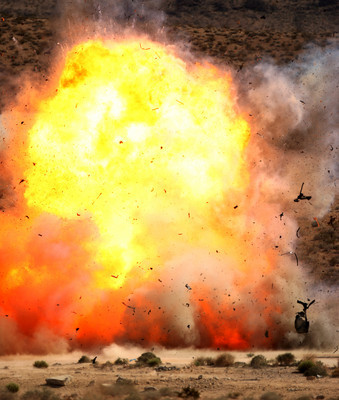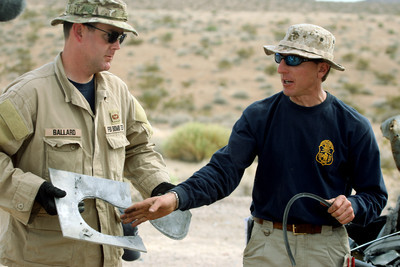Ready to have real blast
They blew up everything from a watermelon to a couple of cars, a van and a turkey.
More than 200 FBI experts on improvised explosive device techniques gathered Thursday at Nellis Air Force Range to learn how terrorists make homemade bombs and watch what happens when they detonate.
"This is science, not art. If we do it right, we can figure out what happened," said Greg Rabinovitz, a special agent with the FBI's bomb squad in Los Angeles who narrated the demonstration.
"That watermelon will go in every direction all at once," he said before a small explosive was detonated.
Similarly, a store-bought turkey, like one that would make for a Thanksgiving Day feast, was blown up to show the effects on tissue.
As the demonstration progressed to more powerful plastic explosives, gasoline, dynamite and ammonium nitrate fuel oil devices, things like tires and office desks were sent hurtling high into the air.
"It doesn't get better than that," Rabinovitz told colleagues as a flaming car tire fell 35 yards from its peak in the sky.
But it did get better when technicians blew a sedan to smithereens with 50 pounds of an ammonium nitrate, fuel oil mixture
The amount was doubled for another car farther away, and a 250-pound ammonium nitrate blast annihilated a white van, leaving a small crater where it was once parked.
For comparison, the same type mixture that American terrorist Timothy McVeigh used to blow up the Murrah Federal Building in Oklahoma City in 1995 was much bigger, in the 5,000-pound range.
"Using something we can buy in a hardware store can create almost something like what the military uses," Rabinovitz said.
Because of that potential, the FBI is trying to create awareness among chemical and explosives suppliers so their products don't wind up in the hands of terrorists.
"What we're doing is laying some trip wires down. ... You lay these trip wires out where (the public) will recognize what's happening," Dave Jernigan, of the FBI's Hazardous Devices School, said about the awareness campaign.
Greg Carl, of the FBI's Terrorist Explosive Devices Analytical Center, said, "Terrorists are very resourceful. They use whatever they get their hands on."
That means in the Mideast more military-type explosives are used, as opposed to chlorate-based devices in Indonesia.
Homemade bombs can contain hundreds or thousands of pounds of high explosives. What's more, they can be used to turn cones of copper or curved strips of metal into a molten projectile that can instantly pierce armor. The devices, known as explosive-formed penetraters, have become a weapon of choice for terrorists in Iraq.
Knowledge gained from the weeklong course that ends today will be shared with first responders at other agencies who might have to react to a terrorist attack.
The effort to train the trainers will serve as a way to keep first responders on the same page in dealing with every type of scenario from pipe bombs and car bombs to more powerful devices that could spread biological, chemical or nuclear materials.
Should a nuclear bomb be found somewhere, Carl said, a special team from the National Nuclear Security Administration would be brought in to disarm it at a remote location like the Nevada Test Site.
Contact reporter Keith Rogers at krogers@reviewjournal.com or (702) 383-0308.
Watch the video


















